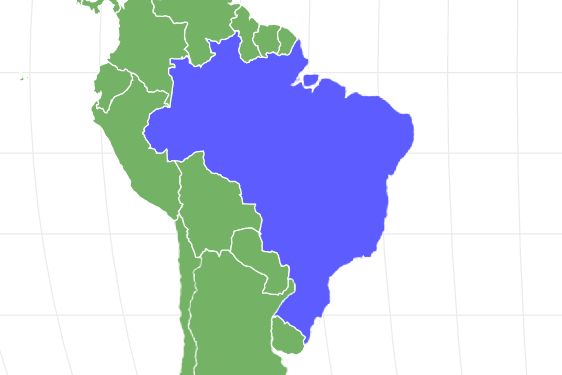Golden Lion Tamarin
Leontopithecus rosalia
Native to the eastern rainforests of Brazil!
Advertisement
Golden Lion Tamarin Scientific Classification
- Kingdom
- Animalia
- Phylum
- Chordata
- Class
- Mammalia
- Order
- Primates
- Family
- Callitrichidae
- Genus
- Leontopithecus
- Scientific Name
- Leontopithecus rosalia
Read our Complete Guide to Classification of Animals.
Golden Lion Tamarin Conservation Status
Golden Lion Tamarin Facts
- Average Litter Size
- 2
- Lifestyle
- Troop
- Favorite Food
- Fruit
- Type
- Mammal
- Slogan
- Native to the eastern rainforests of Brazil!
View all of the Golden Lion Tamarin images!
The golden lion tamarin is a small monkey native to coastal Brazil.
Sometimes called a golden marmoset, it has a long tail, reddish-gold fur, and a dramatic mane that frames its face. Due in part to shrinking habitat, the golden lion tamarin population has dwindled dangerously near extinction, but intensive conservation efforts over the past few years have pulled it back to endangered status. Currently, less than 3,000 individuals occupy the rainforests of Brazil’s southern Atlantic coast.
5 Facts About The Golden Lion Tamarin
- Females typically give birth to twins.
- The golden lion tamarin has a high risk of mortality – close to 50 percent – in its first year of life.
- This type of monkey has an average lifespan of 10 years in the wild.
- It mainly eats fruit, nuts, and small animals.
- It has claw-like nails rather than flat nails like other primates.
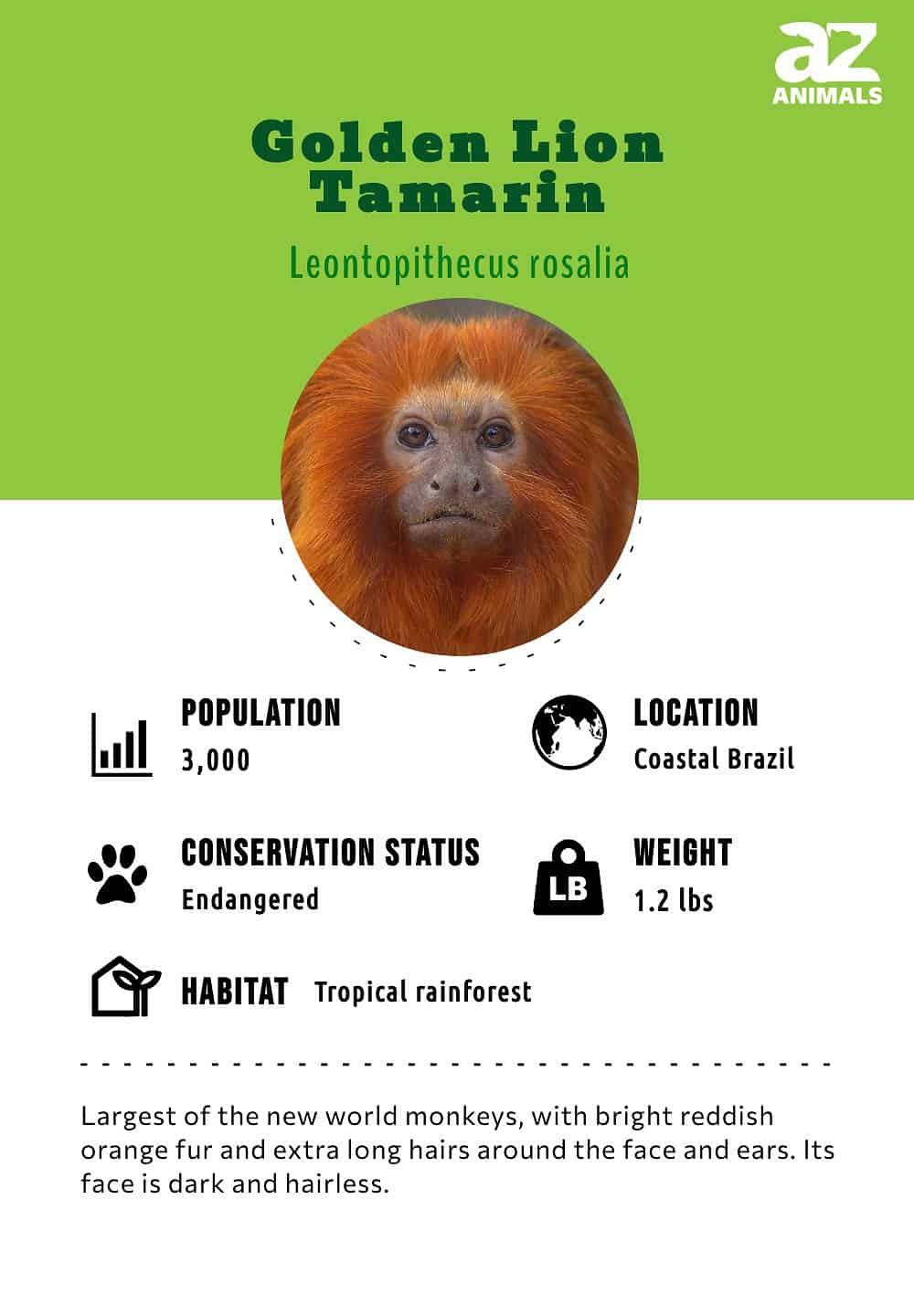
Scientific Name
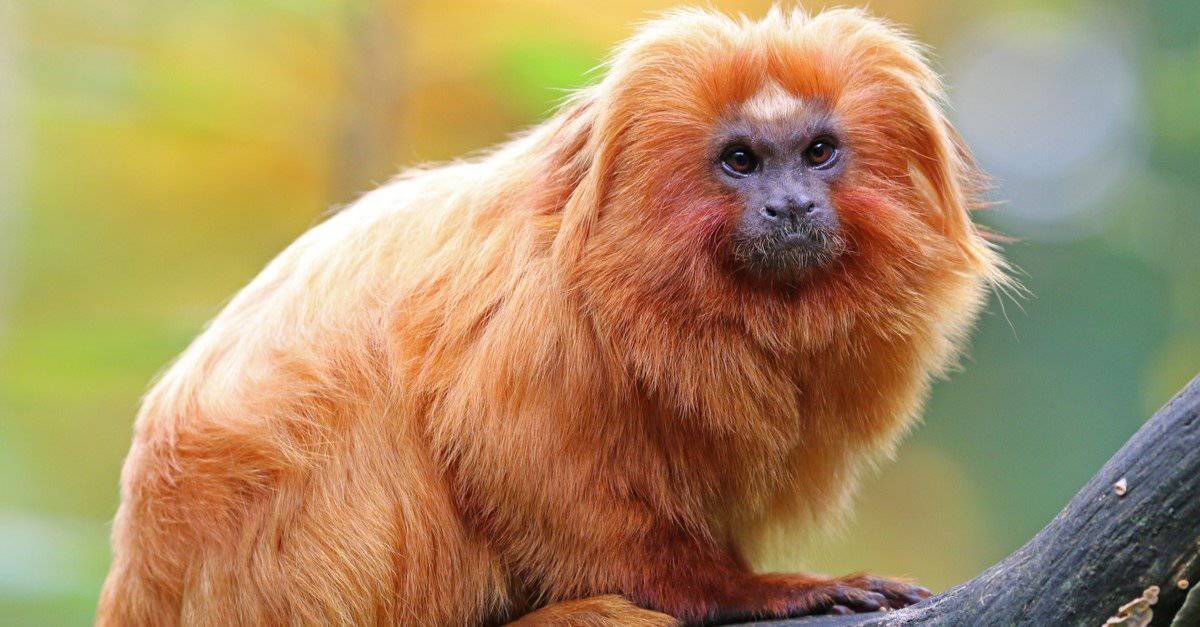
This is a species of small, New World monkey.
©Edwin Butter/Shutterstock.com
The golden lion tamarin is a small, New World monkey that belongs to the Callitrichidae family of arboreal mammals. Its scientific name is Leontopithecus rosalia, which refers both to its lion-like mane and its red coloring. All four tamarin species live in Brazilian rainforests.
Evolution And Origin
As a new world monkey, the golden lion tamarin is a descendant of an ancient African primate that is said to have migrated to South America on a raft constructed of vegetation. Due to a lack of fossil evidence, the exact origin of the early primates is not entirely known. It is believed that new-world monkeys began to appear in the middle of the Cenozoic epoch, during the Paleogene era, around 66 million to 23 million years ago, and they most likely split from the old-world monkeys sometime around 40 million years ago.
Types Of
Also known as the golden marmoset, the golden lion tamarin shares the Leontopithecus genus with three other species:
- Golden-headed lion tamarin or Leontopithecus chrysamelus
- Black lion tamarin or Leontopithecus chrysopygus
- Superagui lion tamarin or Leontopithecus caissara
Appearance
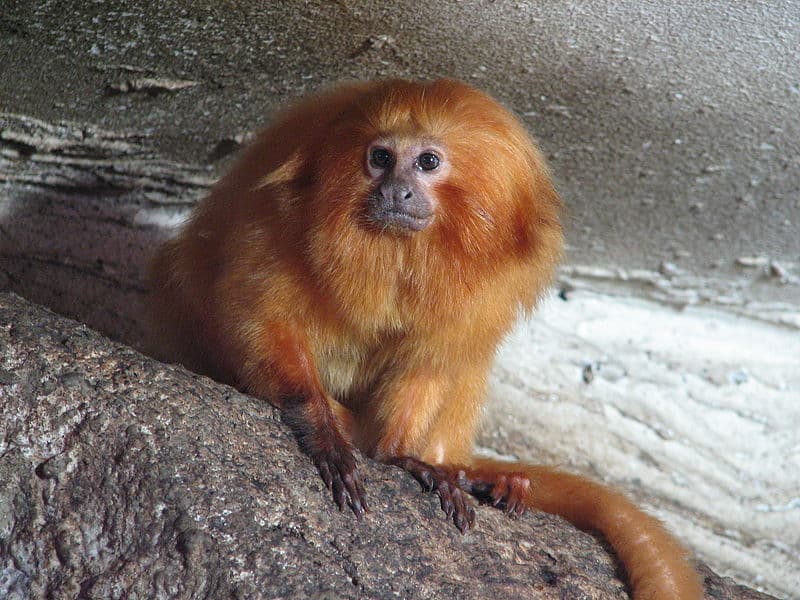
Golden Lion Tamarin has a luxurious reddish-gold coat that covers its entire body with the exception of its face and paws.
©Mistvan – Public Domain
A pint-sized monkey that lives in the trees, the golden marmoset has a luxurious, long reddish-gold coat that covers its entire body except for its face and paws. A ruff of fur frames its furless face and sweeps back over the ears like the mane of a lion, lending this New World monkey an exotic appearance. It also has a hank of red-gold whiskers on each cheek.
The tamarin’s paws resemble hands, but rather than flat fingernails, or ungulae, like those of humans and other primates, the tamarin has claws, which are also called tegulae. These help it dig into tree bark to get the insects it eats and to cling to branches as it travels through the treetops.
The weight range for golden lion tamarins, the largest Leontopithecus species, is between 482 and 680 grams (17 and 24 ounces), so they are about the size of a gray squirrel. Tamarins measure 15 to 25 centimeters in length (6 to 10 inches). Their tails add about 32-40 centimeters (12 to 15 inches) to their length. Males and females are usually similar in size and weight.
Behavior
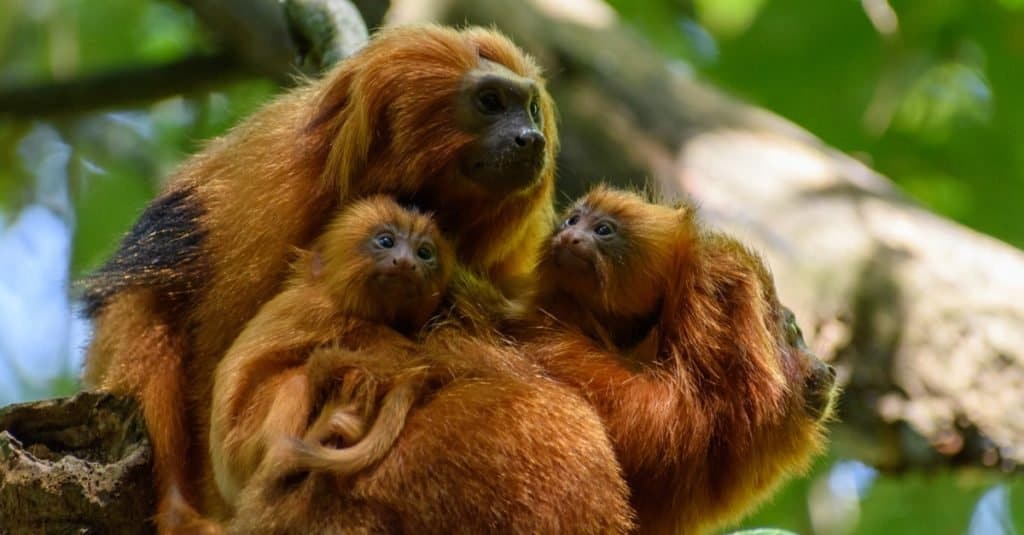
The tamarin is a social creature and has a core group of up to 8 relatives.
©Lucas.Barros/Shutterstock.com
Like squirrels, the tamarin travels on all fours, scurrying between tree branches 10 to 30 meters (29 to 100 feet) above the forest floor. It digs into cracks in the tree bark for insects. It pries into small holes with its deft, hairless fingers. It then shares whatever food is available with its family group.
These arboreal creatures are social within a core group of up to eight relatives. Like other monkeys, they groom each other, and the young ones play together. The mating pair in each family group is typically monogamous for life.
Golden lion tamarin families are part of larger troops that mark their territory with scent to ward off outsiders. They also vocalize whining calls to warn of danger. When they are in an aggressive mode, they arch their backs, open their mouths and stare. They make peeping calls when feeling friendly.
These golden marmosets also have a trilling call in their vocabulary, which they use to let others in their troop know their location. They may cluck when searching for food, and screech in delight when playing.
Groups of tamarins re-nest often as another measure to evade predators. They will nestle in the hollows of trees, bed down on a nest of vines, or another sheltered spot high in the treetops. Their typical daytime routine consists of foraging for fruit and nectar in the morning and then catching insects in the afternoon. In the late afternoon to evening, they choose a new sleeping spot.
Habitat
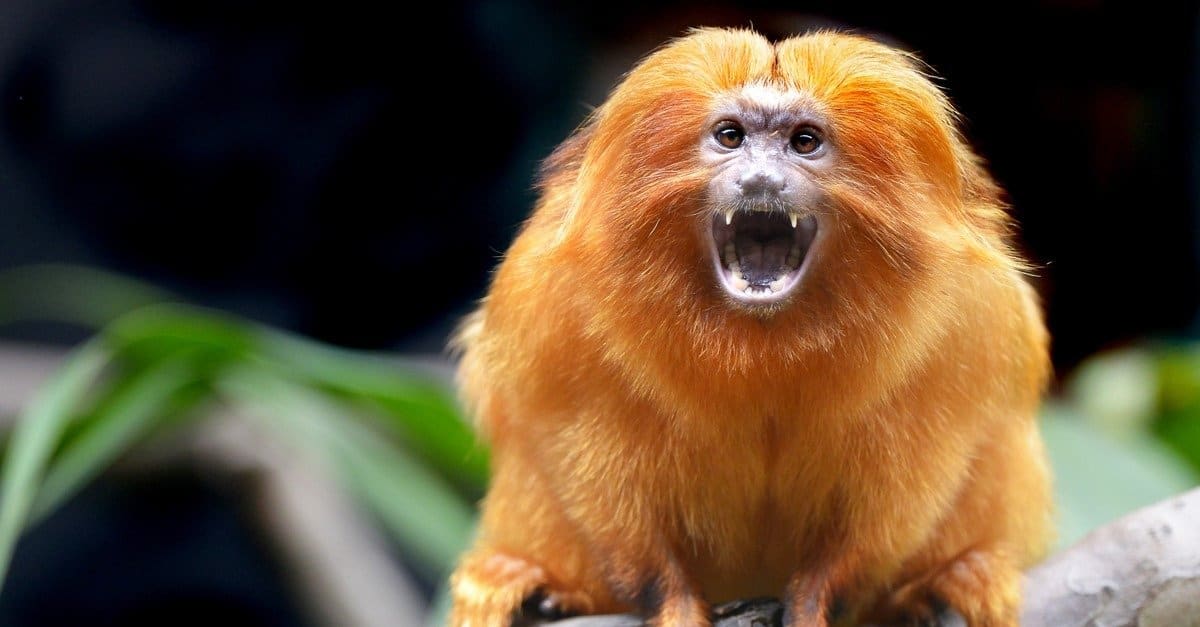
Golden lion tamarins live in habitats that are wildlife preserves all located in Brazil.
©zedithphotography/Shutterstock.com
Golden lion tamarins live in three small regions of southeastern Brazil. Their rainforest habitat has shrunk to less than three percent of its former size due to human activities and encroachment. All three locations are wildlife preserves: Poco das Antas Biological Reserve, Unaio Biological Reserve, and a privately owned reserve that works with the Reintroduction Program, all in the state of Rio de Janeiro.
Different troops have made adaptations to survive in various types of terrain. Due to a fractured habitat, some live in lowland coastal rainforests while others prefer forested hilltops or wetlands along Brazil’s southeastern coast.
Diet
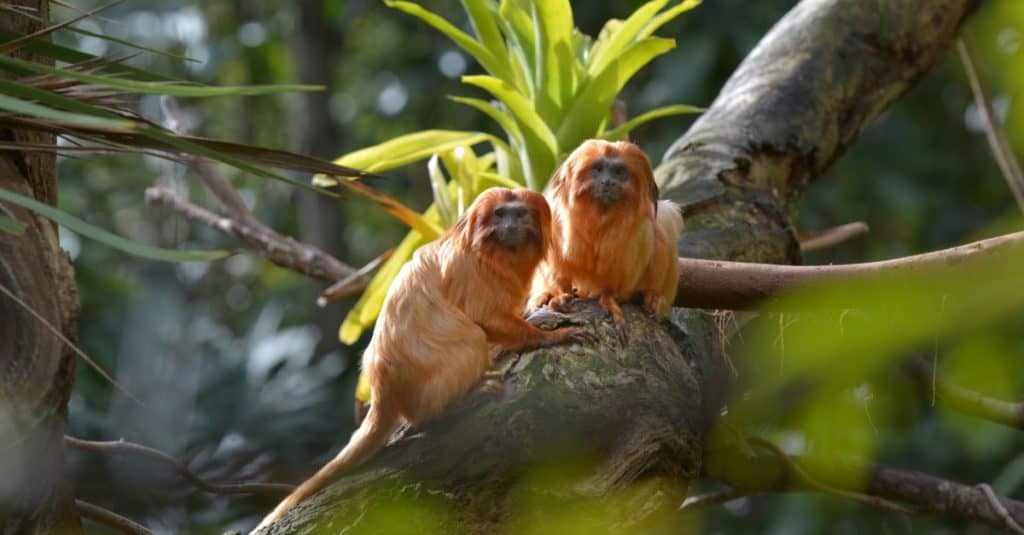
These primates have a diet that is comprised of both animal and vegetable matter.
©ChameleonsEye/Shutterstock.com
These tree-dwelling primates eat a diet of foods available in their rainforest canopy habitat. Because they are omnivores, they eat both animal and vegetable matter. For example, everything from spiders to small lizards finds its way into their diet, depending on local availability and season.
They also feast on flower nectar, tree fruits, and flower petals. Their main criterion in choosing their food is whether it is small enough for them to handle. As they eat and digest fruits and flowers, they naturally disperse the seeds throughout their habitat in their feces, helping to maintain the abundance of the environment.
They enjoy unique adaptations that help them dig into tree bark for the insects they eat. Their slender fingers have claw-like nails rather than the flattened ones specific to other types of monkeys and to humans. These adaptations have another purpose as well. They make it safer for golden lion tamarins to travel through the treetops because their claws help them get a safer grip on the branches, reducing the risk of dangerous falls.
Predators And Threats
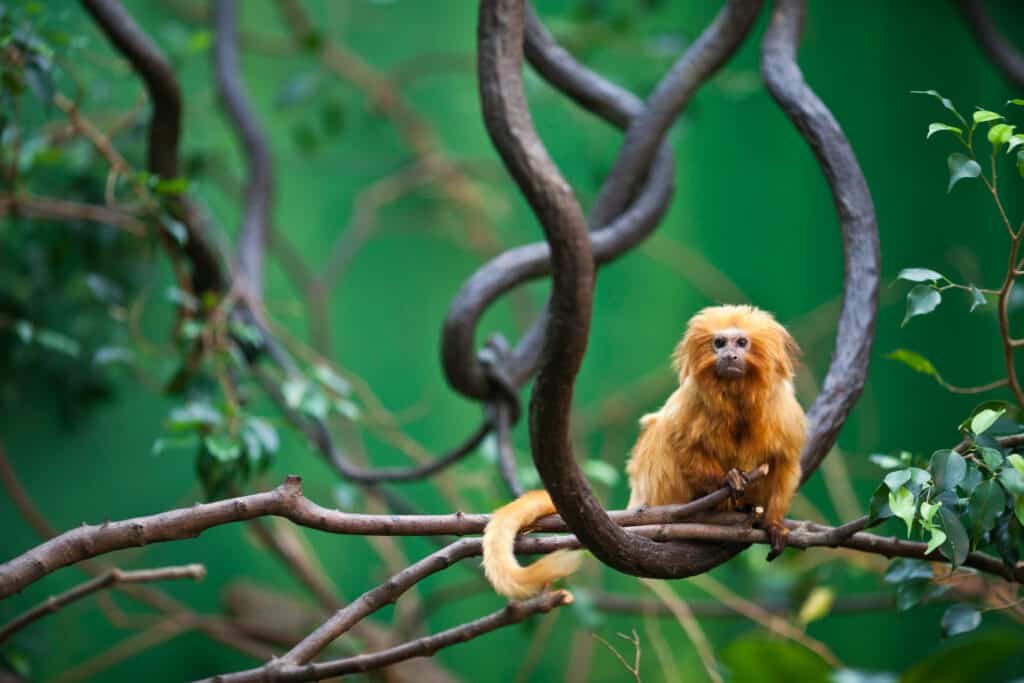
The Golden Lion Tamarin is an endangered species of New World Monkey that lives in Brazil.
©iStock.com/jeancliclac
A few of the animals that share the rainforest with the tamarin, or golden marmoset, prey on it too. Large birds of prey, raccoon-like coatis, snakes and margays, and small Brazilian wildcats all pose a threat of predation to the golden lion tamarin.
Human activities nearly drove tamarins to extinction in the 1960s, and they remain a significant, ongoing threat to the population. Clearcutting tamarin habitat for valuable wood products and charcoal-making has diminished tamarin habitat by 98 percent.
Additional destruction of habitat due to urban sprawl further decimates the tamarins’ homes. Ranchers who cut down forestland to create grazing fields for cattle are another threat to a number of native species, as are big agricultural conglomerates expanding their farming operations.
In the past, the illegal trade in golden lion tamarins further challenged conservation efforts for this small, attractive species. Poachers captured them to sell as pets and zoo exhibits. The strength of the current conservation movement has minimized this once-pervasive threat, however.
Reproduction, Babies, And Lifespan

The golden lion tamarin usually gives birth to twins and on occasion triplets or quadruplets may appear.
©iStock.com/Enjoylife2
Golden marmosets are typically monogamous, with a single mating pair within a family group reproducing. Mating season begins as the rainy season draws to a close between April and June. The gestation time for a golden lion tamarin baby is four months, so the baby will be born sometime between September and February.
Tamarins usually give birth to twins, although occasionally, triplets or quadruplets make an appearance. During the first month after birth, a set of baby tamarin twins depends completely on its mother. She nurses them and carries them on her back.
After those initial weeks, the entire family group helps with childcare and feeding, including the father. A baby typically begins socializing at about 17 weeks.
The dominant female and male of the group can begin reproducing when each is approximately two-and-a-half years old. Other mature males and females do not reproduce until they have formed their own family groups.
Their first year is the riskiest for these infants. The mortality rate for babies under a year of age is nearly 50 percent. After they have survived the critical first year of life, they are young adults.
On average, a golden lion tamarin lives about 10 to 15 years in the wild. The longest-lived are those in captivity. One captive male lived for nearly 25 years.
Population
Although population estimates vary, there are likely about 3,000 golden lion tamarins left in the wilds of Brazil, and nearly 500 living in zoos throughout the world. At its lowest point, the population totaled a scant 200 in the mid-20th century, but since then, numbers have gradually multiplied, thanks to the efforts of conservation groups.
In the Zoo
These small, active primates live in zoos throughout the world. Approximately 38 states in the U.S. host golden lion tamarins too. These include Zoo Atlanta in Georgia, Woodland Park Zoo in Seattle, the Smithsonian National Zoo in Washington D.C., and Audubon Zoo in New Orleans.
View all 170 animals that start with GGolden Lion Tamarin FAQs (Frequently Asked Questions)
Are Golden Lion Tamarins herbivores, carnivores, or omnivores?
Golden Lion Tamarins are Omnivores, meaning they eat both plants and other animals.
What Kingdom do Golden Lion Tamarins belong to?
Golden Lion Tamarins belong to the Kingdom Animalia.
What do golden lion tamarins eat?
These small New World primates eat fruit, vegetables, and meat. They catch small animals to eat, including reptiles and birds. They dig insects such as spiders and beetles out of crevices with their specially adapted claws. In the spring, these golden marmosets drink the nectar from tree blossoms and eat the petals. They feast on fruit when it ripens, and they will eat nuts and vegetation too.
Where does the golden lion tamarin live?
This small monkey species lives in the coastal rain forests of Brazil. Its habitat is limited to four sections of Brazil’s Atlantic coast: the municipalities of Silva Jardim, Cabo Frio, Saquarema, and Araruama. Their habitats are varied and include forested land near sea level, in wetlands, and on hilltops.
How much does a golden lion tamarin weigh?
On average, the weight for a golden lion tamarin ranges between a pound and a pound and a half. Males and females are approximately the same size.
Are golden lion tamarins dangerous?
Although they are about the same size as a gray squirrel, golden lion tamarins can be dangerous if they feel threatened. Their sharp teeth and claws can do some damage. However, these tree-dwellers prefer hiding and fleeing to standing and fighting.
Can you have a golden lion tamarin as a pet?
Some people buy golden lion tamarins illegally and keep them for pets, but the facts are that these wild animals are not obedient and cuddly as dogs and cats. Also, they are an endangered species, so you should not take them from their habitat. Otherwise, these fragile animals could eventually become extinct.
How can you tell different tamarin species apart?
The golden lion tamarin is the largest of the four existing tamarin species in the Leonidas genus, and the only one with red-gold fur all over its body.
The golden-headed lion tamarin has dark fur overall, with a reddish-gold tail, mane, and limbs. This tamarin lives only in the Brazilian state of Bahia.
The black lion tamarin calls Sao Paulo, Brazil, its home. It is black with a golden-colored rump. Researchers estimate that only 1,000 or fewer black lion tamarins remain in the wild.
The Superagui lion tamarin has orange fur with a black head, legs and tail. Its habitat includes Superagui Island and other area islands in the Brazilian state of Parana. This arboreal primate is even rarer than the black lion tamarin. Estimates count their populations as less than 400.
What are the most important steps in protecting the golden lion tamarin from extinction?
One of the most helpful steps that a number of conservation groups have taken is creating a protected habitat for the golden lion tamarin. Virtually all of these small primates now live in publicly or privately protected areas of Brazil. These areas are not under threat from destructive clearing and encroachment of settlements, human activities that, in the past, have nearly wiped out the golden lion tamarin population.
Another important component or tamarin conservation is reconnecting its fragmented habitat through replanting and repairing earlier destruction. Additionally, raising global awareness about the facts of the tamarin’s plight helps strengthen and enforce measures that help the golden lion tamarin species continue to survive.
What class do Golden Lion Tamarins belong to?
Golden Lion Tamarins belong to the class Mammalia.
What phylum to Golden Lion Tamarins belong to?
Golden Lion Tamarins belong to the phylum Chordata.
What family do Golden Lion Tamarins belong to?
Golden Lion Tamarins belong to the family Callitrichidae.
What order do Golden Lion Tamarins belong to?
Golden Lion Tamarins belong to the order Primates.
What type of covering do Golden Lion Tamarins have?
Golden Lion Tamarins are covered in Hair.
What genus do Golden Lion Tamarins belong to?
Golden Lion Tamarins belong to the genus Leontopithecus.
What are some predators of Golden Lion Tamarins?
Predators of Golden Lion Tamarins include hawks, wild cats, snakes, and rats.
How many babies do Golden Lion Tamarins have?
The average number of babies a Golden Lion Tamarin has is 2.
What is an interesting fact about Golden Lion Tamarins?
Golden Lion Tamarins are native to the eastern rainforests of Brazil!
What is the scientific name for the Golden Lion Tamarin?
The scientific name for the Golden Lion Tamarin is Leontopithecus rosalia.
What is the lifespan of a Golden Lion Tamarin?
Golden Lion Tamarins can live for 8 to 15 years.
How fast is a Golden Lion Tamarin?
A Golden Lion Tamarin can travel at speeds of up to 24 miles per hour.
Thank you for reading! Have some feedback for us? Contact the AZ Animals editorial team.
Sources
- Wikipedia, Available here: https://en.wikipedia.org/wiki/Golden_lion_tamarin
- Smithsonian's National Zoo & Conservation Biology Institute, Available here: https://nationalzoo.si.edu/animals/golden-lion-tamarin
- New England Primate Conservancy, Available here: https://www.neprimateconservancy.org/golden-lion-tamarin.html
- Animal Diversity Web, Available here: https://animaldiversity.org/accounts/Leontopithecus_rosalia/
- Save The Golden Lion Tamarin, Available here: https://www.savetheliontamarin.org/zoos-with-glts

